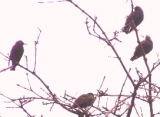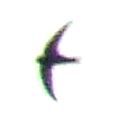Birds N - Z
 The feral pigeon is the Pleasaunce's commonest bird, attracted by people who feed them scraps; also, look out for the large pigeons with a white colar, the wood pigeon.
The feral pigeon is the Pleasaunce's commonest bird, attracted by people who feed them scraps; also, look out for the large pigeons with a white colar, the wood pigeon.
 Not often seen in the Pleasaunce; look out for an undulating flight and intermittent wing beats; that and the red head gives the best chance of identification. The drumming sound of the woodpecking is only heard in spring and is designed to mark out its territory for breeding.
Not often seen in the Pleasaunce; look out for an undulating flight and intermittent wing beats; that and the red head gives the best chance of identification. The drumming sound of the woodpecking is only heard in spring and is designed to mark out its territory for breeding.
 Often seen in numbers screeching quickly across the open glades of the Pleasaunce, in and out of the substantial trees, the ring-necked parakeet has become a familiar site. It has built up in numbers in recent years and now breeds in south east England, becoming one of Greenwich's top ten numerous birds.
Often seen in numbers screeching quickly across the open glades of the Pleasaunce, in and out of the substantial trees, the ring-necked parakeet has become a familiar site. It has built up in numbers in recent years and now breeds in south east England, becoming one of Greenwich's top ten numerous birds.
 Pied wagtals are often seen in the Pleasaunce, feeding on insects on the bowling green.
Pied wagtals are often seen in the Pleasaunce, feeding on insects on the bowling green.
As well as their colour, they can be identified by their bobbing tails, fast running and undulating flight.
 The Pleasaunce plays host to several robins, who defend their own territories in the park aggressively against intruders.
The Pleasaunce plays host to several robins, who defend their own territories in the park aggressively against intruders.
 Starlings often feed closely together and are often seen together in trees like this picture. In winter, thousands can mass together in the countryside, the only bird species in this country to do so. The birds gain their speckled plumage in summer, it gradually fading as the year goes on.
Starlings often feed closely together and are often seen together in trees like this picture. In winter, thousands can mass together in the countryside, the only bird species in this country to do so. The birds gain their speckled plumage in summer, it gradually fading as the year goes on.
 Stock doves are similar in plumage and size to rock doves/feral pigeons. They are largely blue-grey with an attractive iridescent bottle green band on the back of the neck. In flight they show black edges to the wing and two partial black bands near their back.
Stock doves are similar in plumage and size to rock doves/feral pigeons. They are largely blue-grey with an attractive iridescent bottle green band on the back of the neck. In flight they show black edges to the wing and two partial black bands near their back.
 The scythe-like shape of the swift has been seen over the Pleasaunce and captured in this shot by Jason Green, our resident photographer. The birds swoop and circle high in the sky catching tiny insects in their beaks.
The scythe-like shape of the swift has been seen over the Pleasaunce and captured in this shot by Jason Green, our resident photographer. The birds swoop and circle high in the sky catching tiny insects in their beaks.
 In the Pleasaunce, often to be found in the bushes to the west side of the bowling green, the wren is described as a 'tiny bird with a larger than life character'. It has an outstandingly cheerful song but can be difficult to see.
In the Pleasaunce, often to be found in the bushes to the west side of the bowling green, the wren is described as a 'tiny bird with a larger than life character'. It has an outstandingly cheerful song but can be difficult to see.